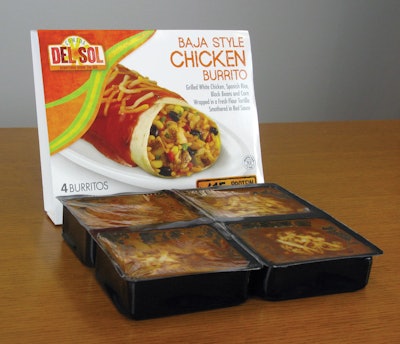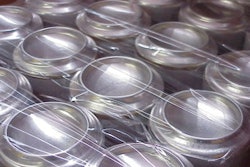Excelline Foods of Chatsworth, CA, is a big believer in fresh, refrigerated foods, says vice president of sales and marketing Noel Bonn.
“We believe the way to the future with food is fresh,” says Bonn. “Across the Atlantic they’ve been doing a great job with it where ready meals are concerned. They see that the frozen food items are starting to dwindle or be eliminated from the retail mix altogether while fresh offerings are growing. We think that’s going to be the trend in the U.S., too, over the next decade or so.”
In January of this year Excelline launched a whole new brand of refrigerated prepared foods called Comida del Sol. Bonn calls the line a significant step up from the frozen “gut fillers” currently out there.
The packaging materials used for Comida del Sol are also intriguing. For both the flautas and the burrito items, the forming web is Plantic eco Plastic high-barrier material from Plantic Technologies. It’s made using a corn crop that is specifically grown for Plantic Technologies Ltd. The whole of the harvested crop is used and Plantic uses the extracted starch to make its biopolymer packaging material; the byproduct goes to animal food and fertilizer. Due to a highly efficient conversion rate, says Plantic, there is minimal crop space required, and the crop has no impact on food-growing land space requirements. The firm’s patented polymer technology is based on the use of high-amylose corn starch, a material derived from annual harvesting of specialized non-genetically modified (hybrid) corn and supplied by Corn Products International. The biopolymer is comparable in cost to other conventional plastic packaging materials, says Plantic.
Plantic eco Plastic consists of a core layer that is extruded in a conventional manner. Laminated to this core layer are skin layers of polyethylene (largely for heat-sealing purposes) and polypropylene (for moisture barrier). Total thickness in the Excelline Foods application is 450 microns, and of that, 410 microns is the Plantic material at the core. The Oxygen Transmission Rate, says Plantic, is less than 0.05 CC/sq m/24 hr at 23°C.
Plantic eco Plastic is not biodegradable due to the presence of the non-biodegradable skin layers that surround the starch core. Plantic notes that a process to separate the starch core from the skins has been developed. In the meantime, says Plantic, this material is not considered a significant contaminant in mixed polymer recycling processes. The firm also notes that the material is certified as a bio-based product by Vincotte, an accredited inspection and certification organization based in Belgium. The certification of three stars indicates that the material is made of up to 89% renewable content.
‘Fits with our standards’
“The environmental benefits of Plantic eco Plastic combined with the ability to meet our shelf life demands provide a package that truly fits with our high standards and naturally fresh image,” says Carlos Angulo, CEO of Excelline Foods. “All of our products are handmade using only the freshest ingredients and natural preservatives to bring our customers the highest quality Mexican foods available.”
According to Bonn, the Plantic material is used by Excelline in two formats. For 12 flautas weighing a total of 42 oz and selling for about $10.00, Excelline uses rollstock material on a modified-atmosphere Multivac thermoform/seal system. The formed trays are manually filled with six flautas in one half of the two-compartment package and six in the other half. The filled trays are backflushed with nitrogen to drive out ambient oxygen and then a clear barrier lidding material is applied. Refrigerated shelf life is about 37 days.
A burrito product, on the other hand, which is packaged on the same Multivac machine, is packaged under a partial vacuum and then sent through High-Pressure Processing (HPP) to give it a 60-day refrigerated shelf life. The burrito version has a net weight of 40 oz and also sells for about $10.00. Both items are intended to serve more than one, and a serving can be eaten by the consumer after it’s been microwaved for a few minutes. The microwaving is not supposed to be done in the package, and instructions on the packaging make this clear.
While the flautas thermoform is a clear two-compartment pack, the burrito thermoform is black and consists of four units with a perforation that consumers use to divide the four-pack into a two pack.
So why HPP for the burritos and not for the flautas? Because the burritos have a cheesy sauce poured over them before the lidding is applied. “The combination of that moisture, the cheese, and the pH balance means that the burritos are a very different product than the flautas, and our research told us that the HPP would be very helpful,” says Bonn. “The flautas aren’t sitting in a cheese sauce and thus have a very different consistency.”
The HPP provider used by Excelline Foods for the burritos product is State Fish Co.. Lidding material for the Comida del Sol line comes from Sunrise Packaging Films (www.sunpak.net). A couple of lidding film structures have been used, and both include a gas-barrier component. One is a PVdC-coated polyester laminated to 2.5 mils of PE. The other is a nylon/EVOH/polyethylene coextrusion.
Club stores represent the primary channel in which these products are carried, where both sell for about $10. Distribution is nationwide.
“When we designed these entries into the casual Mexican dining category, we wanted to minimize the packaging footprint as much as possible,” says Bonn. “So when Sunrise Packaging alerted us to this Plantic material, we felt it was just what we needed: a plant-based material made primarily from renewable resources that still has good gas barrier properties.”





























